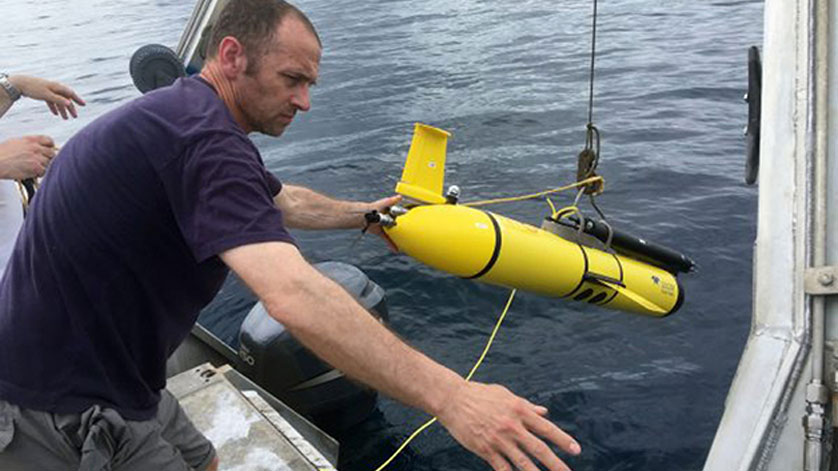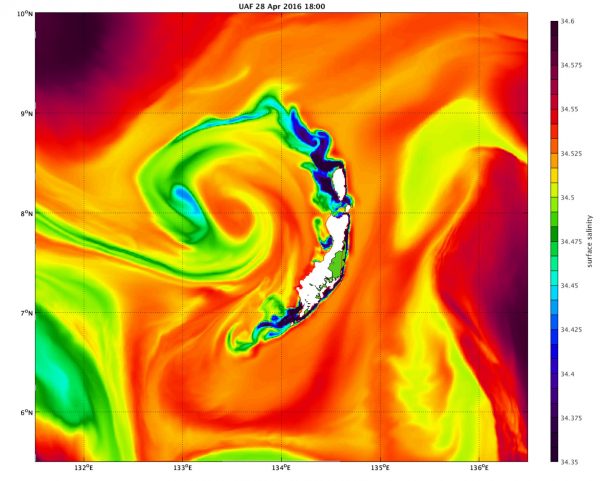UAF Researcher Goes with the Flow of Ocean Currents

Not all ocean research involves living on a ship for a month, counting whales, or diving underwater and collecting data beneath the surface of the ocean.
Many physical oceanographers study ocean circulation — how ocean currents move from region to region. This often involves sitting at a computer and creating models that can simulate circulation patterns from past data and project future patterns based on the current understanding of the way things work. This is similar to how a meteorologist models weather patterns.
Weather models are used daily to project the range and direction of large and small storm systems, predict future temperatures, and more. Similarly, ocean circulation models can help us begin to understand how ocean currents move not only ocean water, but nutrients, animals, plastics and other materials all over the world.
Harper Simmons, a physical oceanographer at the University of Alaska Fairbanks College of Fisheries and Ocean Sciences, studies ocean circulation patterns from Alaska to Palau, a small country consisting of hundreds of islands in the western Pacific Ocean.
Oceanographically, there’s a strong current near Palau that runs parallel to the equator. But a lot of little islands in the western Pacific, including Palau, disrupt this flow pattern. Simmons is particularly interested in the wakes that form behind Palau’s islands.
Global ocean circulation patterns have enormous implications for what can grow or thrive in different parts of the ocean. This is because ocean currents help carry nutrients — the food sources for plants and animals at the bottom of the food chain — from one area to another.
“As you can imagine, if a current is moving uninterrupted toward an island, the current will have to be diverted to go around the island,” Simmons said. “This causes vorticity, a disturbed state where water from the deep ocean mixes with water at the surface. The upwelling of deep water introduces new nutrients to the surface ocean.”
These deep-ocean nutrients attract plants and animals offshore of Palau, which in turn allows rich coral reef ecosystems to thrive around Palau. But plants and animals are not the only ones to benefit. Human populations on islands surrounded by coral reefs have vibrant fisheries and excellent opportunities for scuba diving and other tourist attractions.
 A model output of ocean salinity shows how Palau’s islands disrupt ocean circulation. Salinity levels are high in ocean water moving toward the island on the right side of the model output, but drop when they come into contact with the island (shown by the dark blue surrounding the islands), and create a pocket of low salinity conditions moving away from the island. Model by Harper Simmons
A model output of ocean salinity shows how Palau’s islands disrupt ocean circulation. Salinity levels are high in ocean water moving toward the island on the right side of the model output, but drop when they come into contact with the island (shown by the dark blue surrounding the islands), and create a pocket of low salinity conditions moving away from the island. Model by Harper Simmons
“Palau has its own very famous ecosystem, which is dependent on the offshore ecosystem both as a valued fishery and a source of tourism,” explained Louis St. Laurent, an oceanographer from the Woods Hole Oceanographic Institution who often collaborates with Simmons on modeling projects. “Being able to better measure how these nutrients are moving is important for our understanding of the highly productive region. But for me, I’m simply fascinated by the way the currents move.”
While oceanographic cruises reveal important information about different cycles and processes at specific places and points in time, it can be challenging to generalize these findings to understand processes at larger regional scales, or over greater periods of time. Such models help researchers apply the trends that have been studied on oceanographic cruises to larger scales. Although modelers are not out on ships dropping fancy equipment to the depths of the ocean, their calculations can provide information that just isn’t possible with ship-going research.
Simmons uses hindcast models, which simulate events that happened in the past with new information that wasn’t available at the time of the event.
“A lot of my work is super abstract,” he said, “but a broader application of the modeling is to help us better understand how nutrients come in and out of ocean systems.”
Oceanographic models can inform other important processes as well, Simmons said. One of the surprising results of the research is that the hindcast models have done a surprisingly good job at predicting future circulation patterns, which is not a main goal of the model. This suggests that a modeling system like this could one day be used to assist search and rescue operations, or for oil spill trajectory calculations.
Simmons often works with St. Laurent, who studies ocean currents by collecting water samples using robotic sampling systems. Their research in Palau is supported by the Office of Naval Research.
Laurent said the partnership benefits both researchers. Simmons uses his models to help St. Laurent identify where to collect samples, depending on what the researchers are trying to figure out. Then St. Laurent can share the data from his samples, which Simmons uses to refine and enhance his models.
Research is still in progress, but both scientists are pleased with how the models have been performing in the Palau region. “Every time we do a study like this, we learn that the actual systems and processes never fail to be more complex than we expected,” St. Laurent said. “But even though these systems are complicated, they still follow patterns. We hope that our research will continue to bring more clarity to these patterns.”

